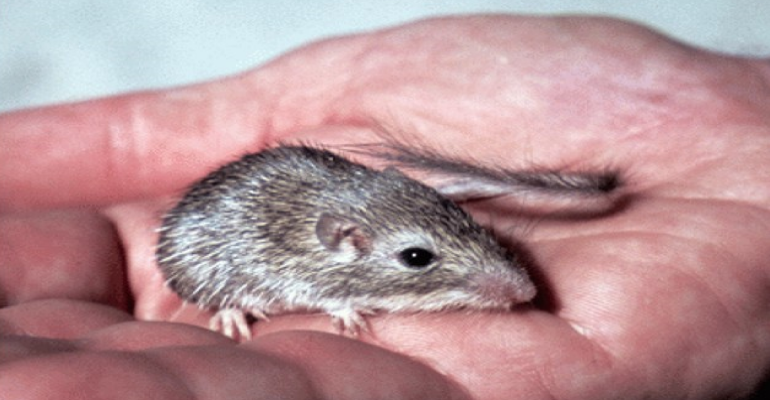
Pocket mice are well-adapted to desert living. They seldom drink water and can exist entirely on a diet of dry seeds. They are able to live on the small amount of water produced from metabolizing carbohydrates.
According to the Arizona-Sonora Desert Museum (ASDM): “They spend the days underground in the burrow, where in summer the humidity is higher and the temperature lower than above ground. The entrance hole is usually plugged to keep the moisture from escaping to the dry air above. The kidneys of these rodents concentrate the urine to a viscous consistency, reducing water loss. When temperatures become extreme, some pocket mice go into a torpor, or estivate [short-term temporary hibernation]. These animals are solitary and defend small territories, often fighting when they encounter each other.”
Pocket mice are almost entirely nocturnal. During the night, they forage for seeds, eating mainly mesquite beans and the seeds of grass, creosote bushes, and other plants. They carry the seeds in cheek pouches and cache them in their dens.
Pocket mice are in the family Heteromyidae. ASDM says “Despite their names, they are neither rats nor mice; and in spite of their mouse-like appearance, they are not closely related to any other species of North American rodent.” But pocket mice are in the same family as Kangaroo rats which are also able to live on moisture derived from dry seeds. (Is this classification taxonomic nitpicking?)
There are 35 species in North America according to Encyclopedia Britannica , which they describe as follows:
The nine species of silky pocket mice (genus Perognathus) are very small, weighing from 5 to 30 grams (0.2 to 1.1 ounces) and having a body length of 6 to 9 cm (2.4 to 3.5 inches) and hairy tails 5 to 10 cm long. Silky pocket mice have soft fur ranging from yellowish to gray on the upperparts and white to buff on the underparts; soles of the hind feet are furry, but in all other pocket mice the soles are hairless.
The 15 species of coarse-haired pocket mice (genus Chaetodipus) are larger on average, weighing 15 to 47 grams and having a body length of 8 to 13 cm and hairy, tufted tails as long as or much longer than the body (up to 15 cm). Coarse-haired pocket mice are similar in colour to silky pocket mice, but the fur is harsh and the rump has spiny bristles. Silky and coarse-haired pocket mice range from western Canada and the United States into southern Mexico, where they inhabit open desert country.
The five species of spiny pocket mice (genus Liomys) are found in extreme southern Texas, but they live mostly in Mexico southward to Panama in semiarid brushy and rocky habitats. These pocket mice weigh 34 to 50 grams and have a body length of 10 to 14 cm and long tails of up to 16 cm.
The seven species of forest spiny pocket mice (genus Heteromys) are the largest, weighing from 37 to 85 grams and having 11- to 18-cm bodies and long scantily haired tails. Forest pocket mice range from southern Mexico to northern South America, where they live from sea level upward into mountains. All the spiny pocket mice have harsh fur made up of stiff, bristly hairs that may be gray, reddish brown, dark brown, or glossy black. In some species a rust-coloured strip separates upperparts and underparts.
See photos from Google Images. You will notice quite a variation in color. Apparently pocket mice can evolve rapidly to take on the color of their surroundings. There have been several studies of this feature, for instance:
The genetic basis of adaptive melanism in pocket mice: “Rock pocket mice are generally light-colored and live on light-colored rocks. However, populations of dark (melanic) mice are found on dark lava, and this concealing coloration provides protection from avian and mammalian predators.”
ASDM notes: “Because there are many of these little rodents and they are closely related to each other, each species has evolved with different foraging times and places, which minimizes competition. Bailey’s pocket mouse, for example, climbs up into desert wash vegetation to find seeds and berries still on the plants, while the desert pocket mouse hunts along the ground in washes and open areas for seeds. Merriam’s kangaroo rat, a creature of open, creosote flats, tends to dash from one clump of bushes to the next, overlooking seeds out in the open spaces, leaving those for other mice to find. In this way many species of heteromyid mice and rats can share the same environment.”
The website: http://www.nhptv.org/wild/heteromyidae.asp lists 62 species of the family Heteromyidae world-wide (this includes kangaroo rats).
Related articles:
Note to readers: I have constructed a linked index to more than 300 of my ADI articles. You can see it at: https://wryheat.wordpress.com/adi-index/
You can read my comprehensive, 28-page essay on climate change here: http://wp.me/P3SUNp-1bq
https://wryheat.files.wordpress.com/2014/10/climate-change-in-perspective-2015.pdf
